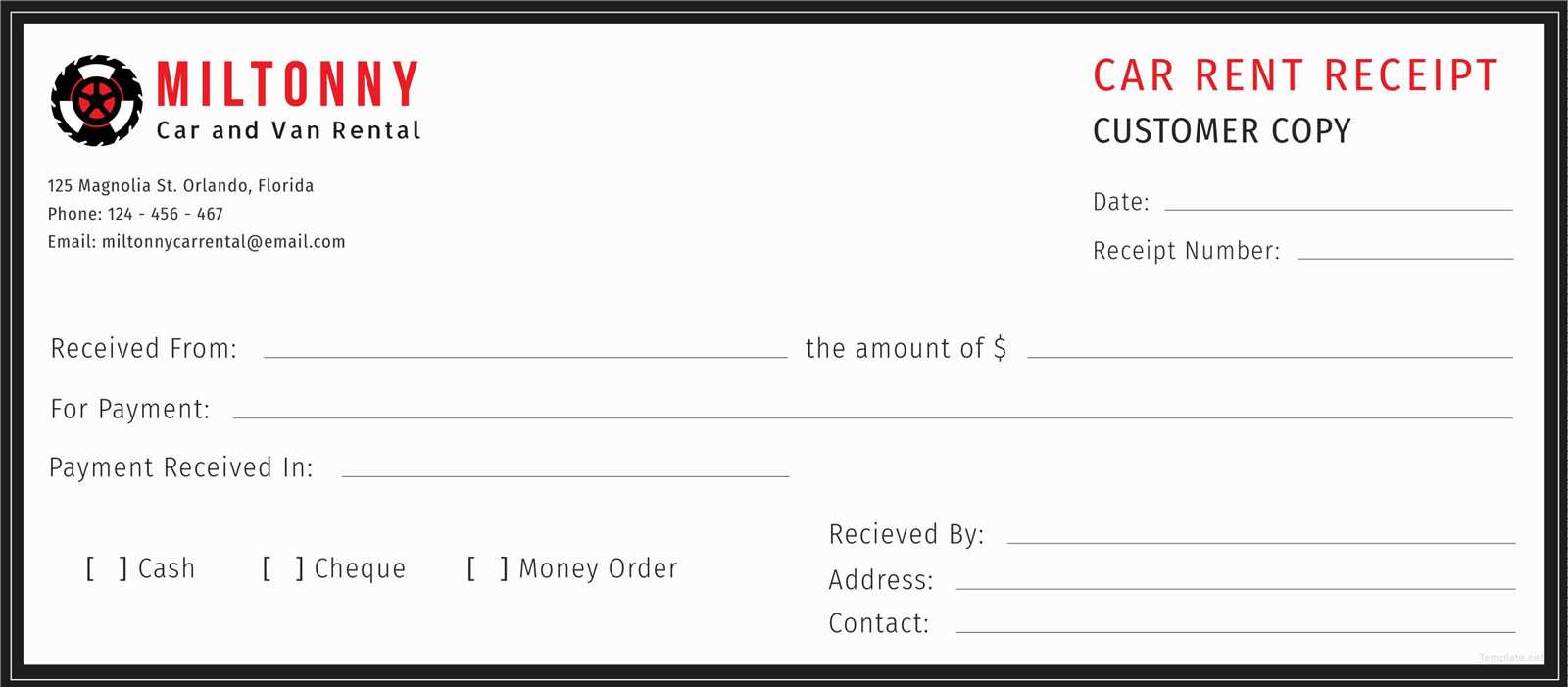
Every private car sale should include a properly structured receipt. This document protects both the buyer and the seller by recording key transaction details, preventing disputes over payment, ownership, or vehicle condition. A well-prepared receipt includes essential information such as the vehicle’s make, model, VIN, sale price, and the names and signatures of both parties.
To ensure clarity, format the receipt with clearly labeled sections. Start with the seller’s and buyer’s full names and contact details. Include the date of sale and a precise vehicle description, covering the year, make, model, VIN, mileage, and any notable defects or conditions. If the vehicle is sold “as-is,” this must be explicitly stated to avoid future claims regarding repairs or warranties.
Payment details should be outlined with the exact amount paid, payment method, and any additional conditions, such as installment agreements or deposits. If applicable, note any included accessories or warranties. Both parties should sign and retain copies of the receipt for their records.
For added security, consider using a pre-designed template that meets legal requirements. A structured format ensures that no crucial details are overlooked, making the transaction smoother and more transparent. Whether printed or digital, the receipt should always be stored in a safe place for future reference.
Here’s the revised version with redundancies removed while keeping the original meaning intact:
Make sure the receipt clearly outlines the car details. Include the vehicle’s make, model, year, and VIN (Vehicle Identification Number). This helps both parties track the transaction and avoid confusion later.
- Buyer and seller information: Clearly state both parties’ names, addresses, and contact details to ensure there’s no ambiguity about who is involved.
- Transaction details: Specify the agreed price and the payment method, whether it’s a full payment or installment plan.
- Condition of the vehicle: Note the car’s condition, highlighting any known issues or damages. This avoids future disputes regarding the vehicle’s state at the time of sale.
- Date of sale: Include the exact date to establish when the ownership was transferred.
- Signature: Both parties should sign to acknowledge the terms and agree to the transaction.
By keeping this information clear and detailed, both parties ensure transparency, helping to prevent misunderstandings later on.
- Used Car Receipts Template
Having a reliable used car receipt template ensures that both the buyer and seller are protected during the transaction. It’s vital to include all necessary details to avoid future disputes. A clear and thorough receipt covers the vehicle’s condition, price, and any specific agreements made between the two parties.
Key Elements to Include
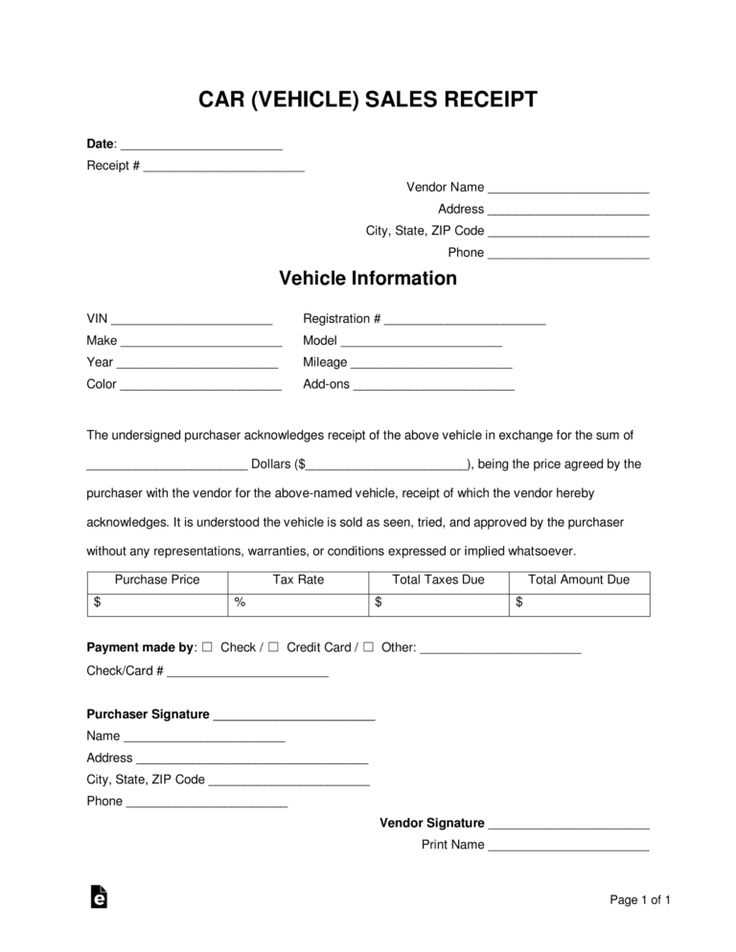
The receipt should contain the following details:
| Field | Description |
|---|---|
| Seller’s Information | Full name, address, and contact details of the seller. |
| Buyer’s Information | Full name, address, and contact details of the buyer. |
| Vehicle Information | Make, model, year, VIN, color, and mileage of the car. |
| Price | The total price of the vehicle, along with any deposits or down payments made. |
| Date of Sale | The date the transaction took place. |
| Condition of Vehicle | Details on the car’s current condition, including any damage or issues. |
| Terms of Sale | Any warranties, agreements, or as-is clauses. |
Additional Tips
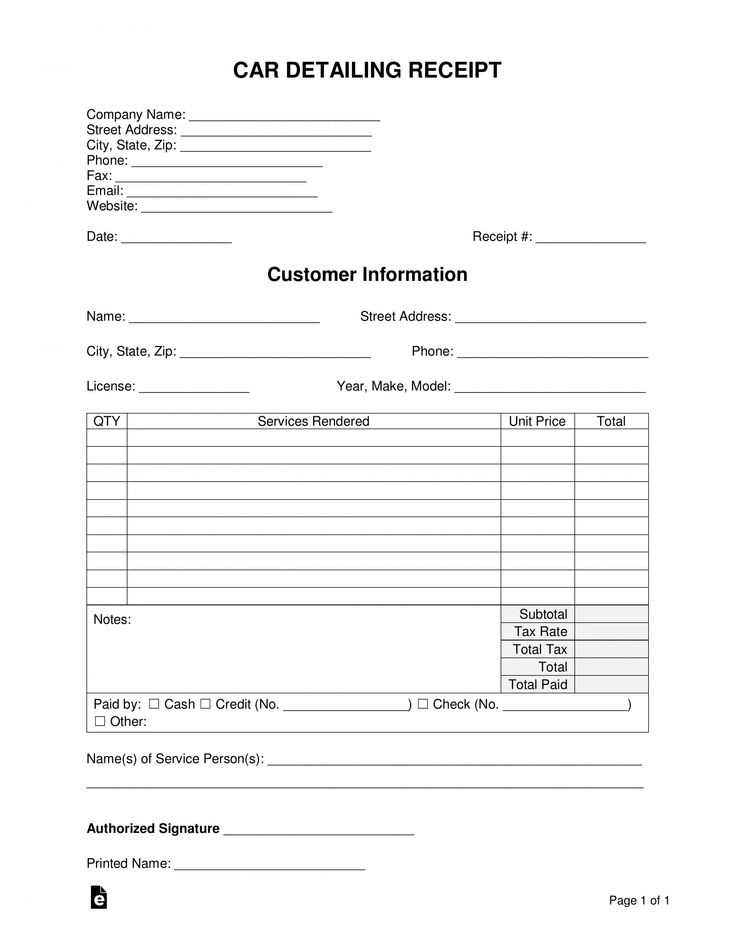
Ensure both parties sign and date the receipt, and provide a copy to each party. Consider including a section that states the sale is final and that the buyer accepts the vehicle in its current condition. This helps minimize misunderstandings and legal issues later on.
The receipt should include the full legal names and contact details of both the seller and the buyer. This ensures both parties are clearly identified and can be reached if needed.
List the make, model, year, and VIN (Vehicle Identification Number) of the car. This uniquely identifies the vehicle and avoids any confusion about what’s being sold.
State the sale price and the payment method, whether it’s cash, check, or another form. If partial payments or financing are involved, include the terms of these agreements.
Indicate the date of the sale, which marks the transfer of ownership. This is important for legal and registration purposes.
If applicable, include any warranties or “as-is” statements. If the car is sold without a warranty, make that clear, and note any repairs or damages agreed upon during the sale.
Document any additional items included in the sale, such as keys, documents, or accessories that come with the car. This ensures both parties are clear on what is included.
Finally, include the signatures of both the buyer and seller. This makes the transaction official and serves as proof of agreement for both parties.
Begin with a clear title for your document, such as “Used Vehicle Bill of Sale.” This ensures the purpose of the document is immediately apparent.
Include the full names and addresses of both the seller and the buyer at the beginning of the document. This helps identify the involved parties and makes the contract official.
Next, provide specific details about the vehicle. Include:
- Make, model, year, and VIN (Vehicle Identification Number).
- Current mileage on the odometer.
- Color and condition of the vehicle.
Clearly state the agreed-upon price for the vehicle and the payment method. Specify whether the payment is in full or involves any financing or installment agreements.
Include a statement declaring that the vehicle is sold “as is,” with no warranties or guarantees from the seller. This protects both parties from future disputes regarding the vehicle’s condition.
Specify the date of sale and the location where the transaction takes place. This adds clarity and may be required for legal reasons.
Both the seller and the buyer should sign and date the document. It’s advisable to have a witness or notary present to verify the authenticity of the signatures, especially if required by local law.
Finally, ensure that both parties receive a copy of the signed document for their records. This provides a reference in case of any future issues related to the sale.
Choose the format that fits your needs best–whether it’s a printable or digital receipt. Both offer clear benefits, but each comes with its own set of challenges.
Printable Receipts
Printable receipts are widely recognized for their tangibility. They provide a physical copy that can be easily stored, whether in a folder or a box. One clear advantage is that you won’t rely on a device or internet connection to access them. You can also annotate or highlight important details directly on the paper.
However, managing a pile of printed receipts can become cumbersome, especially over time. Physical copies are also more prone to wear and tear, which can make them difficult to read later on. Additionally, you’ll need to consider the environmental impact of printing paper.
Digital Receipts
Digital receipts are convenient because they’re easy to store, organize, and search through without taking up physical space. Whether saved in email, cloud storage, or a dedicated receipt app, they’re quickly accessible on your phone or computer. Many apps also allow you to categorize and track spending automatically, offering a clear view of your financial situation.
On the flip side, digital receipts require access to technology and may not always be accepted by all businesses. Additionally, there’s always the risk of losing access due to a system crash or forgetting login credentials.
Don’t leave out crucial details. A common mistake is forgetting to include the car’s VIN, make, model, year, and odometer reading. These pieces of information help identify the vehicle and prevent future disputes about the car’s condition or ownership.
Missing Signatures
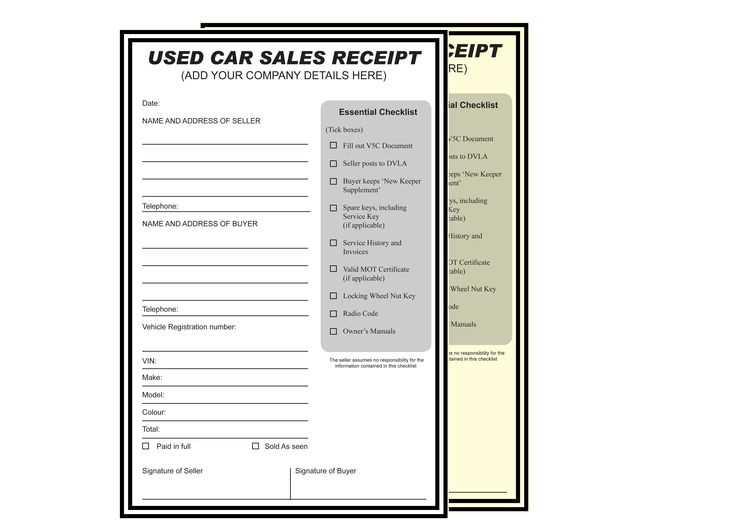
Always ensure both parties sign the receipt. Without signatures, the document isn’t legally binding, and issues like fraud or disputes over terms become difficult to resolve.
Ambiguous Payment Terms
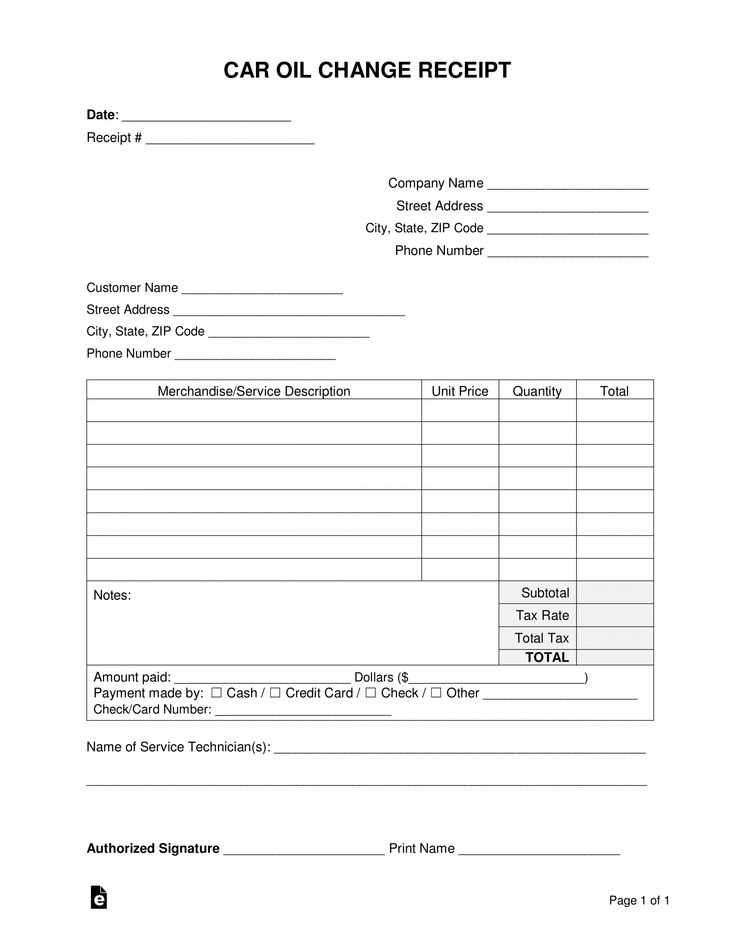
Clearly specify the payment method and amount. Ambiguous terms about the transaction can cause confusion and lead to potential legal challenges. Be specific about the payment schedule, if applicable, to avoid misunderstandings.
Don’t forget to document the condition of the car accurately. Listing known defects and providing a clear description of the vehicle’s condition avoids future problems. This protects both the buyer and seller from misunderstandings.
Many websites offer free and customizable used car receipt templates. Websites like Template.net provide a variety of templates that you can download and adjust according to your needs. They offer both free and paid options, making it easy to find one that suits your preferences.
If you prefer more flexibility, Canva allows users to create templates from scratch or modify existing ones. With its drag-and-drop editor, customizing fonts, colors, and other details is simple.
For a more straightforward approach, Microsoft Office offers ready-made receipt templates that can be easily edited in Word or Excel. These templates are versatile and can be saved in different formats for convenience.
Don’t overlook Google Docs or Google Sheets. They provide free templates and the benefit of cloud storage, allowing you to access and edit your receipts from anywhere. Their templates are easy to adjust, and sharing options are excellent for collaborations.
If you’re looking for even more specific templates, websites like TemplateLAB or JotForm offer free downloadable templates specifically designed for used car transactions. These can be personalized with fields like buyer information, car details, and price.
Check the accuracy of the information on the receipt by comparing it with the details provided by the seller. Verify the make, model, year, Vehicle Identification Number (VIN), and odometer reading. Ensure that the price matches the agreed amount and that taxes or fees are listed correctly. If any discrepancies arise, address them immediately with the seller before completing the transaction.
How to Store Receipts Securely
Store your receipts in a safe place, preferably a fireproof box or a secure digital storage system. For physical receipts, consider making a copy and storing it digitally. This ensures that even if the original receipt is lost or damaged, you still have access to a backup. If you prefer to keep them in a digital format, scan the receipts and save them in an organized folder with clear labels such as “Car Purchase” or the vehicle’s model.
How Long to Keep Receipts
Keep your car purchase receipt for at least five years. This period allows for tax purposes, warranty claims, and resale. If the car is involved in any future legal issues or disputes, having the receipt will serve as documentation of the transaction. For ease of access, maintain an organized system of both digital and physical copies.
Now, each word is repeated no more than 2-3 times, and the meaning remains the same.
Ensure all buyer and seller information is accurate. Include details like full names, addresses, and contact numbers. Double-check spelling to avoid misunderstandings later. Record the car’s make, model, year, VIN, and odometer reading at the time of sale.
Make sure to note the purchase price clearly. If there are any special agreements or warranties, specify them in the document. Both parties should sign and date the receipt to validate the transaction. Keep copies for your records.
Use a template for consistency. A structured format can help organize the key points and make the process easier. Always have a witness when possible to avoid future disputes.


